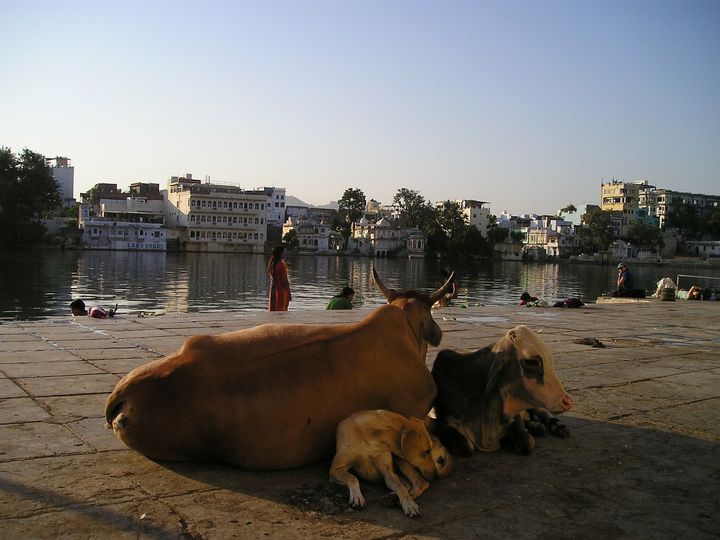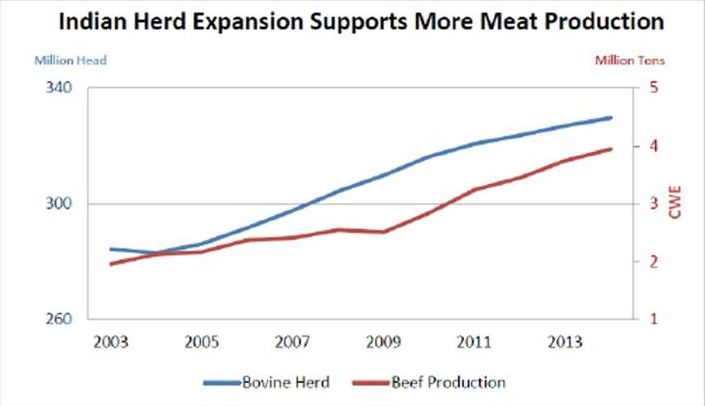
Cows have traditionally been given respect in Hinduism and in India, but a recent spate of violence related to cattle has spawned a huge debate in India with gau maata in the crosshairs.
Consider the following thought experiment. Suppose the Government of India drastically alters its own policies and messaging regarding the exportation, transport, and slaughter of cattle. Suppose that after this set of policies goes into effect, there are a dozen or so attacks on individuals with cattle allegedly featuring prominently in the motive. Suppose further that those killed or seriously injured in these attacks happened to all belong to the same religious denomination. These attacks are followed by deafening silence by those in power. Soon, the initial set of policies is taken up as a major issue by the political Opposition. Some commentators derisively censure this plank, while others enthusiastically support its breakthrough.
The question before us is, how do we connect these dots, if at all? Should we link these deaths to the government’s actions and charge it with complicity for its quiescence? When reporting on and discussing these crimes, should we assume a communal angle?
For those readers familiar with the Indian socio-political landscape, the scenario narrated above is hardly a thought experiment but rather a tangible reality. But perhaps not in the way you might expect. For those who mentally answered “yes” to the questions in the preceding paragraph, you are holding the UPA government responsible for a spate of cattle-related murders and assaults that occurred between 2013-16.
Yes, you read that last sentence correctly. Let’s review the specifics of the scenario now, as I did in an earlier piece published on this platform in 2013. In 2009-10, the then Union Minister for Food Processing Industries, Subodh Kant Sahai, initiated policy shifts in the meat processing industry squarely aimed at both increasing demand for and easing the cost of production of red meat— a “Pink Revolution.”
Shri Sahai hoped his Revolution would “increase meat consumption from 6g per capita to 50g per capita.” In other words, while the rest of the world had begun to embrace vegetarianism for reasons of ethics and sustainability, the Indian government was concertedly focused on reversing the age-old, salubrious tradition that had existed in India for centuries. (As an aside, Sachin Pilot of the Congress Party was at my University this past semester and remarked that the UPA government had never sought to influence what people ate, like what the present government is doing—I wonder aloud how Mr. Pilot would respond to the words of his own party colleague and minister.)
Indeed, achieve these ends they did. Between 2009 and 2014, Indian exports of beef shot up from 609,000 tonnes to 2,082,000 tonnes (242% increase), whereas the global increase was only 34%. In aggregate terms, global beef exports saw an increase of 2,545,000 tonnes (USDA), for which India alone accounted for 58%.

Beef production in India took off after 2009, after moderate growth in the preceding period.
“So, what?” you may ask. Earlier, I argued that such policies foreseeably collided with engrained Hindu ethos and unnecessarily set up conflict between Hindus and Muslims, the two largest religious communities in India. But there is also a very important economic angle to all of this. The efforts of Shri Sahai included the provision of subsidies to the meat processing industry on the order of 25-60%, meant solely for the “transport of meat, pre-cooling facilities, cold storage, brand publicity, quality control, packaging development, brand publicity, etc.” (TOI) Thus, a sizeable economic incentive was delivered directly to the enterprise of slaughter, reducing barriers for entry while simultaneously creating a huge demand for livestock for these new entrants.
This spawned an impetus for illegal activity. In May of 2013, The New York Times’ Gardiner Harris did a piece on the growing spate of illicit cow trafficking occurring in India. Harris notes that traffickers often worked in tandem with the newly minted slaughterhouses, providing them with the livestock needed to operate. More serious, however, were the violent tendencies of those involved:
The desperados — driving souped-up dump trucks — think little of ramming police cars and breaking through barricades. They have even pushed cows into the pathways of their pursuers, forcing horrified officers to swerve out of the way to avoid what for many is still a grievous sin.
And so, from 2013 onwards, these traffickers committed over a dozen murders and assaults on innocent Hindu farmers who often relied on these livestock for their subsistence. These are catalogued here and here. Though you may never have heard of them, in sheer numbers, these crimes reach the level of the current phenomenon of lynching suspected beef-eaters. It’s not your fault, though; after all, these attacks were a topic of public engagement for neither the UPA government nor for the media. In sum, the UPA government enacted changes to policy that ultimately and foreseeably led to the murders of Hindu livestock owners and displayed reckless indifference by refusing to acknowledge that anything was amiss. As a footnote to this narrative, the BJP also deserves brickbats for failing to institute the police and policy reforms necessary to reverse this horrible trend (note the attacks by cattle smugglers continued beyond May 2014).
Now that I have filled in the blanks in the opening paragraph, I repeat my questions to you again. How would you answer them? Do you agree with the way that I’ve connected the dots in the above account? You have every right to answer, “no.” But doing so is a tacit acceptance that the current spate of lynchings cannot be laid at the doorstep of the current Indian government, either. After all, I have neatly filled in the same blanks with different identities and events in a cogent fashion. Answering “yes,” on the other hand, also forces one to consider from where the class of homicidal gaurakshaks sprang up. Isn’t it more realistic that they organically grew out of a perceived need to protect cows from a growing number of traffickers than the ad hoc explanation that they are the Frankenstein monster of the BJP?
Perhaps you are still dissatisfied because you feel Prime Minister Modi’s reactions to the current lynchings are tardy homilies. Not enough. You draw an association here with his alleged reluctance to a “wink-wink” acceptance of communal violence. Yet, how many times has the PM spoke out against the communal violence against Hindus in Malda and more recently, Basirhat, in West Bengal? What does his silence here portend?
I have no quarrel with those who protested the recent wave of lynchings; truly, I believe the vast majority was acting according to its conscience and perceived responsibility. No, what bugs me is this idea of India as “Lynchistan.” For, in truth, the idea at the heart of #NotInMyName— that the Indian populace is suddenly being driven by a mob mentality where the life of every Muslim person is in danger due to an ascendant Hindu majority is a gross, dangerous overreaction to a narrative that is woefully incomplete at best, and wholesale bunkum at worst.
The above comparison serves as a reality check to two of the central themes of this “Lynchistan” narrative:
- That minorities in India have been at the victims of this type of grisly violence almost uniquely; they are literally being killed for what they choose to eat.
- That the rate at which these attacks have occurred has rapidly increased.
For the second of these themes, the only attempt at a statistical basis has come from Rupa Subramanya, an incisive commentator that I’ve had the rare pleasure of meeting. In a piece titled “Has India Become Lynchistan?,” Subramanya shows that “mob violence has been ticking upward since the BJP came to power in 2014.” Her analysis also underlines that the annual share of cow-related incidents in communal violence has increased since 2014 from 5% to 23% in early 2017. However, she places the caveat that the dataset she has constructed is derived from media sources. She considers but ultimately rejects the possibility that “the uptick in mob violence is driven entirely by increased reportage after the BJP’s victory.”
Post Subramanya’s weighing in on the subject, Shubham Verma, a research fellow at the Public Policy Research Centre in New Delhi, determined that precisely the kind of media bias Subramanya worries about actually exists. He compares two different sets of communal crimes—similar in their nature (location, manner of violence, etc.) but with victims or perpetrators from different communities. He arrives at the conclusion that the Indian media tends to privilege and sensationalize coverage of communal violence of Hindus against Muslims and upper-caste Hindus against Dalits. Verma also indicates that complaints received from the National Commission of Minorities (NCM) have decreased since 2014. This suggests that any claim that Hindus are lynching Muslims for eating beef in an unprecedented wave should be taken with a huge grain of salt.
Media treatment that portrays or privileges a certain narrative is not new and often emanates from in-born assumptions. In early 2015, for instance, a similar phenomenon happened with respect to the Christian community in India. At that time, attacks on churches and a gangrape of a nun were highlighted, the media giving the off-hand impression that suddenly, churches were being targeted by mobs of Hindutva vandals. In the end, it was discovered that these crimes were, in fact, accidents or unrelated to mob violence altogether, and the gangrape of the nun in West Bengal was committed by Bangladeshi migrants. In 2015, data showed that mandirs and gurudwaras had been attacked at a higher rate than churches.
And while the Indian media hasn’t learned its lesson, we in the Indian diaspora certainly should. The effect of such narratives is to stoke fear within minorities where that fear has little basis. If you were a religious minority in India and all you saw were pictures of people who looked, worshiped, and lived as you do being viciously attacked on the news, you would certainly react with anxiety, if not terror. Oftentimes, this type of media coverage is both justified and necessary. For instance, media coverage in the U.S. has in the recent past highlighted police brutality against African Americans and other POC’s because other ethnicities in similar scenarios would have been dealt with vastly differently. The focus on targeting of minorities there is also supported by and commensurate with data, no matter what #AllLivesMater tells you.
In the case of reportage in India, however, the opposite seems true. Rather than projecting the plight and hurt that minority communities feel, the Indian media often ends up manufacturing it by throwing an exclusive spotlight on the incidents that buttress this narrative. The next time such an incident happens and we see it on the news, it only further reinforces our confidence in the narrative. Soon, everyone is up in arms. Those who would balk at associating religious terminology with terror are suddenly blasting social media with #HindutvaKills and #BrahmanismKills. “Progressive” forces are butchering cows on the streets or organizing beef-eating festivals.
How we choose to connect dots can have important ramifications. Surely, if all of this can happen on a flimsy foundational pretext with scant data, a certain amount of introspection and review of our own assumptions is in order. Else, we will continue to turn the same stones over, again and again.
